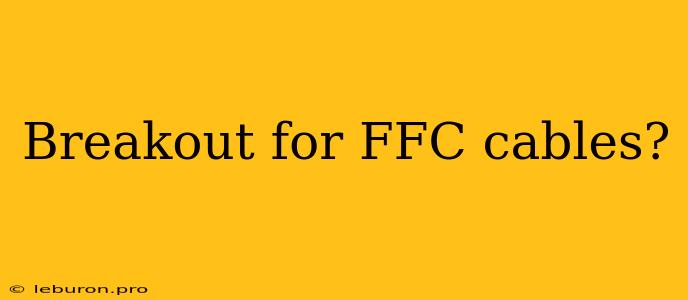Breakout for FFC Cables: Unraveling the Complexity
The ever-evolving realm of electronics demands intricate connectivity solutions, and among them, FFC (Flexible Flat Cable) cables stand out as a reliable and versatile choice. However, the intricate nature of FFC cables often necessitates the use of breakout cables, posing a challenge for engineers and designers seeking a seamless integration. This article delves into the world of breakout cables for FFC cables, exploring their purpose, applications, advantages, and considerations for successful implementation.
What are Breakout Cables?
Breakout cables, in the context of FFC cables, are specialized connectors designed to break out the individual conductors from a flat cable into separate, discrete wires. This breakout process allows for greater flexibility in connecting the FFC cable to various devices and circuits. Breakout cables effectively transform the compact FFC cable into a series of individual wires, facilitating easier termination and connection to different components within a system.
The Need for Breakout Cables in FFC Applications
FFC cables, known for their flexibility and compact design, excel in applications requiring a high density of signals in a limited space. They are commonly used in devices like:
- LCD screens: FFC cables connect the LCD panel to the controller board, transmitting video signals and control data.
- Keyboards and Mice: FFC cables enable the transfer of keystrokes and mouse movements to the connected computer.
- Industrial Automation: FFC cables are utilized in robotics and automation systems, facilitating data transfer between components.
- Medical Devices: In medical equipment, FFC cables play a crucial role in transmitting data between sensors and control units.
- Consumer Electronics: FFC cables find widespread use in smartphones, tablets, and other portable devices.
However, the inherent design of FFC cables poses a challenge when connecting them to devices requiring individual wire connections. Breakout cables bridge this gap, enabling the conversion of the compact FFC cable into a series of independent wires, simplifying the connection process.
Types of Breakout Cables for FFC
Breakout cables for FFC connectors come in a variety of configurations, catering to specific application needs. Some common types include:
1. Straight Breakout Cables:
These cables feature a straight connection, offering a simple and direct connection between the FFC cable and the individual wires. Straight breakout cables are ideal for applications requiring a direct connection without any significant change in direction.
2. Right-Angle Breakout Cables:
Right-angle breakout cables provide a 90-degree bend, allowing the breakout wires to exit at a right angle to the FFC cable. This configuration is beneficial when space constraints necessitate a change in the direction of the wires.
3. Pigtail Breakout Cables:
Pigtail breakout cables feature short, individual wires extending from the FFC connector. These short wires, known as pigtails, offer flexibility in connecting the breakout cables to components, enabling the use of different connectors and terminations.
4. Custom Breakout Cables:
For complex and specialized applications, custom breakout cables can be designed to meet specific requirements. Custom solutions allow for the precise configuration of the breakout cable, including the number of wires, length, connector type, and other specifications.
Advantages of Using Breakout Cables for FFC
Breakout cables for FFC cables offer numerous advantages, contributing to the overall success of the application. Here are some key benefits:
- Simplified Termination: Breakout cables facilitate the easy termination of the FFC cable by providing individual wires that can be connected to standard connectors.
- Increased Flexibility: The use of breakout cables enables the connection of FFC cables to a wider range of components and devices, enhancing flexibility in system design.
- Enhanced Reliability: By reducing the stress on the FFC cable and connector, breakout cables can contribute to a more robust and reliable connection.
- Reduced Space Consumption: Breakout cables can help manage wire clutter, minimizing space consumption and promoting better cable management.
- Signal Integrity: The use of high-quality breakout cables ensures signal integrity, preserving the accuracy and reliability of the transmitted data.
Considerations for Choosing the Right Breakout Cable
When selecting a breakout cable for FFC applications, several factors should be taken into account to ensure the optimal solution is chosen.
1. FFC Cable Type:
The choice of breakout cable must be compatible with the FFC cable being used, including factors like the number of conductors, pitch, and connector type.
2. Breakout Wire Type:
The wire gauge, material, and insulation of the breakout wires should be selected based on the current requirements and the application environment.
3. Connector Type:
The connectors on the breakout cable should match the desired connection points on the target device, ensuring a secure and reliable connection.
4. Length and Configuration:
The length and configuration of the breakout cable should be tailored to the application, allowing for easy routing and connection while minimizing stress on the cable.
5. Environmental Factors:
Considerations such as temperature, humidity, and exposure to chemicals should be taken into account when selecting the materials and construction of the breakout cable.
Conclusion: Breaking Out the Potential of FFC Cables
Breakout cables for FFC cables are essential components for integrating FFC cables into various applications. By transforming the compact FFC cable into a series of individual wires, breakout cables simplify termination, increase flexibility, and enhance reliability. When selecting a breakout cable, considering the FFC cable type, breakout wire type, connector type, length, and environmental factors is crucial to ensure the success of the project. By leveraging the advantages of breakout cables for FFC connections, engineers and designers can unlock the full potential of FFC technology, contributing to the development of innovative and efficient electronic systems.
